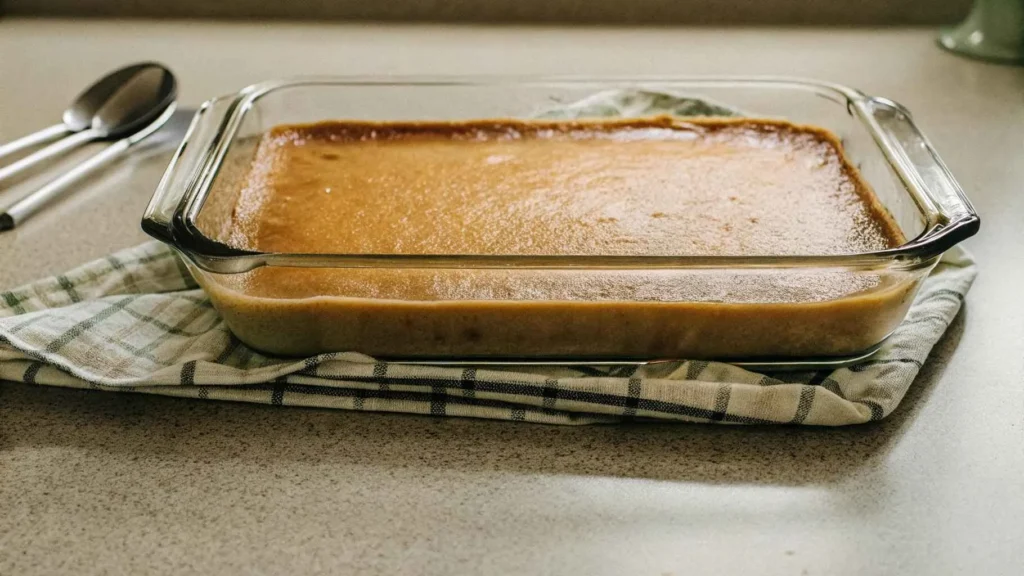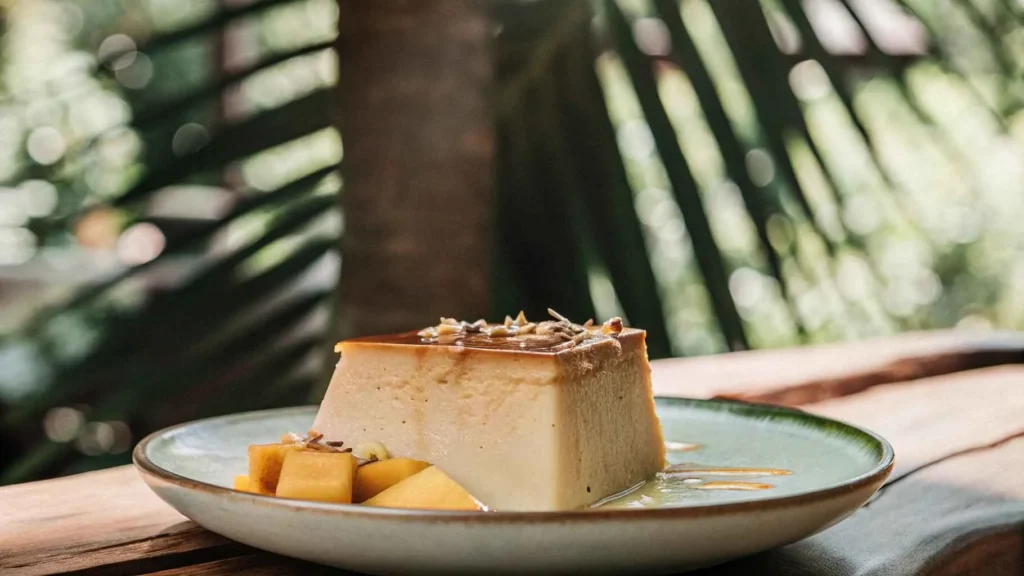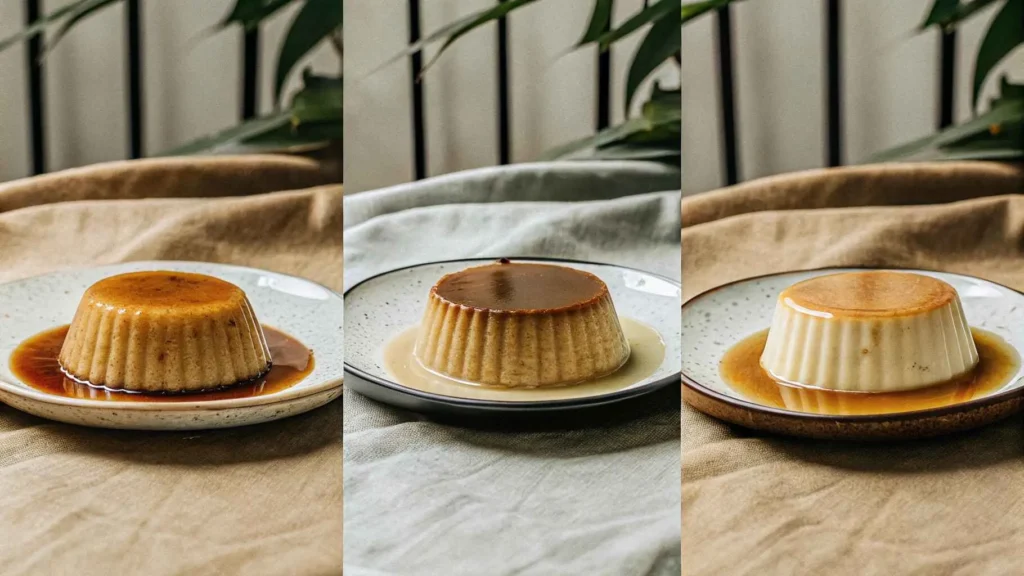Introduction
The Rich History and Cultural Significance of Flan de Coco
Flan is one of the most beloved desserts in Latin America, with deep roots in Spanish and French cuisine. Originally derived from the Roman-era custard, flan gained popularity in Spain during the Middle Ages. The Spaniards later introduced it to the Americas, where each country developed its own version. Among these variations, flan de coco stands out as a tropical twist that perfectly blends tradition with the rich flavors of coconut.
Coconut flan is especially popular in Caribbean and coastal Latin American regions, where coconuts grow abundantly. Countries like Puerto Rico, the Dominican Republic, Venezuela, and Colombia have embraced flan de coco as a staple dessert at family gatherings, holidays, and special occasions. The creamy, smooth texture combined with the sweet, nutty essence of coconut makes it a favorite among dessert lovers.
Why You Need to Try Flan de Coco
If you love classic flan, you’ll be amazed by the depth of flavor that coconut brings to this traditional dessert. Here’s why you should make flan de coco today:
- Perfectly Creamy Texture – The blend of coconut milk and sweetened condensed milk creates an ultra-smooth custard.
- Tropical Flavor Twist – The subtle sweetness of coconut adds a refreshing and exotic taste.
- Easy to Make – This recipe is straightforward, even for beginners.
- Naturally Gluten-Free – For those wondering, is flan gluten-free? Yes, it is! This makes it a great option for gluten-sensitive individuals.
- A Crowd-Pleasing Dessert – Whether you’re hosting a dinner party or making a sweet treat for the family, coconut flan is always a hit.
What to Expect in This Recipe
In this recipe, you’ll learn how to make flan de coco from scratch using simple ingredients like coconut milk, eggs, and caramelized sugar. We’ll walk through every step, from preparing the caramel to achieving the perfect silky texture. Along the way, you’ll also discover helpful tips, delicious variations like pumpkin flan and flan casero, and answers to common flan-making questions.
Get ready to indulge in a luscious, tropical dessert that will transport your taste buds to the Caribbean!
Table of Contents
Ingredients Needed for Flan de Coco
To make a delicious flan de coco, using high-quality ingredients makes all the difference. The creamy, smooth texture of the flan depends on the richness of the coconut milk, the sweetness from the condensed milk, and the eggs that bind everything together. For an extra layer of flavor, the addition of vanilla extract and shredded coconut will make the flan even more irresistible.
Here’s a breakdown of all the ingredients you’ll need to create the perfect flan de coco:
| Ingredient | Quantity |
|---|---|
| Coconut milk | 1 can (14 oz) |
| Sweetened condensed milk | 1 can (14 oz) |
| Evaporated milk | 1 can (12 oz) |
| Eggs | 4 large |
| Sugar | 1 cup |
| Vanilla extract | 1 teaspoon |
| Shredded coconut | ½ cup (optional) |
| Water (for caramel) | ¼ cup |
- No pork, bacon, wine, alcohol, beer, or similar ingredients are included in this recipe, making it suitable for a variety of dietary preferences.
- The shredded coconut is optional, but if you love the texture and enhanced coconut flavor, it’s highly recommended.
Using these simple ingredients, you’ll be able to create a rich, flavorful flan with a smooth, silky consistency and the irresistible tropical taste of coconut.
How to Make Flan de Coco (Step-by-Step Guide)
Making flan de coco is a simple yet satisfying process that results in a rich, creamy, and smooth dessert. Follow these easy steps, and you’ll have a delicious coconut flan that will impress everyone!
Step 1: Prepare the Caramel
The first step in making flan de coco is preparing the caramel, which will form the top layer of the flan once it’s unmolded.
How to Melt Sugar to Make a Rich, Golden Caramel
- Place 1 cup of sugar in a saucepan over medium heat.
- Stir the sugar constantly as it begins to melt. It will turn into a liquid and start to bubble.
- Continue stirring until the sugar becomes a rich golden brown color.
- Once the caramel reaches the desired color (a deep amber), immediately pour ¼ cup of water into the pan to stop the cooking process. Be careful – the caramel will bubble up when the water is added!
- Stir to ensure the sugar is fully dissolved into the water, then remove from heat.
Tips for Avoiding Burnt Caramel
- Keep the heat medium-low to avoid burning the sugar.
- Never walk away from the sugar while it’s melting, as it can go from golden to burnt very quickly.
- If the caramel starts to get too dark too quickly, add the water and remove from the heat to prevent it from becoming bitter.
Once your caramel is ready, pour it carefully into the bottom of a flan mold or baking dish. Tilt the dish to ensure the caramel coats the bottom evenly, and set it aside to cool and harden while you prepare the flan mixture.
Step 2: Blend the Flan Mixture
Now it’s time to mix the ingredients that will make up the creamy, silky custard of the flan.
Mixing Coconut Milk, Eggs, and Condensed Milk for a Creamy Texture
- In a large mixing bowl, combine 1 can of coconut milk, 1 can of sweetened condensed milk, and 1 can of evaporated milk.
- Crack 4 large eggs into the bowl and whisk them together with the milk mixture.
- Add 1 teaspoon of vanilla extract and ½ cup of shredded coconut (optional) for extra flavor.
- Mix everything thoroughly until the ingredients are well incorporated, creating a smooth batter.
The Importance of Straining the Mixture for Smoothness
After blending the ingredients, it’s crucial to strain the flan mixture to remove any egg bits or coconut pieces that may have formed during mixing. This ensures your flan has a perfectly smooth texture.
- Pour the mixture through a fine mesh sieve or cheesecloth into another clean bowl to catch any impurities.
- Strain it into your prepared caramel-coated mold or baking dish.
Step 3: Baking the Flan
Flan is best baked using a bain-marie or water bath, which ensures even cooking and a creamy texture.
Using a Bain-Marie (Water Bath) for Even Cooking
- Preheat your oven to 350°F (175°C).
- Place the flan mold into a larger baking dish.
- Fill the larger dish with hot water until it reaches halfway up the sides of the flan mold. This water bath helps the flan cook evenly without cracking.
- Carefully transfer the baking dish to the oven.
Ideal Baking Temperature and Time for the Perfect Set
- Bake the flan for about 50-60 minutes or until the flan is set. You can check for doneness by gently shaking the mold – if the flan jiggles slightly in the center, it’s done.
- If the top of the flan starts to brown too much during baking, you can cover it loosely with aluminum foil to prevent burning.
Step 4: Cooling and Unmolding
Once your flan has finished baking, it’s time to cool and unmold it to reveal the beautiful caramel layer on top.
How Long to Chill for the Best Consistency
- After removing the flan from the oven, allow it to cool at room temperature for about 15 minutes.
- Once it’s cooled slightly, transfer the flan to the refrigerator and chill for at least 4 hours, but preferably overnight. The longer it chills, the better the texture.
The Best Way to Flip and Serve Your Flan Casero Without Breaking It
- To unmold the flan, run a butter knife or spatula around the edges of the flan to loosen it from the sides of the mold.
- Place a large plate or serving dish over the top of the flan mold and quickly invert it.
- Gently lift the mold off, and you’ll be left with a perfectly unmolded flan with a smooth caramel layer on top.
Serve chilled, and enjoy the creamy, coconut-infused goodness of your homemade flan de coco!

With these clear and simple steps, you’ll have a delightful coconut flan to share with family and friends. Keep in mind that baking the flan requires some patience, but the end result is absolutely worth it.
Expert Tips for the Perfect Coconut Flan
Making a flawless flan de coco takes a little bit of care, but with these expert tips, you can ensure that your dessert turns out creamy, smooth, and absolutely delicious every time. Here are some valuable tips for perfecting your coconut flan:
1. Avoiding Air Bubbles for a Silky Texture
Air bubbles in your flan mixture can result in an undesirable texture and prevent your flan from being as smooth and creamy as it should be. Here are a few tricks to avoid air bubbles:
- Mix Gently: When whisking the eggs into the milk mixture, do so gently to avoid incorporating too much air. Overbeating can lead to bubbles that disrupt the custard’s silky texture.
- Strain the Mixture: Straining the mixture through a fine mesh sieve before pouring it into the mold removes any air bubbles that have formed during mixing. It also eliminates any solid bits, ensuring a smooth custard.
- Avoid Overbaking: Baking the flan at the right temperature and for the right amount of time is essential. Overbaking can cause the custard to puff up and then collapse, creating unwanted texture issues. Ensure that the flan is just set in the middle before removing it from the oven.
2. Best Substitutes for Common Ingredients
If you’re looking to make a few adjustments or simply don’t have certain ingredients on hand, here are some great substitutes for common flan de coco ingredients:
- Coconut Milk: If you’re out of coconut milk, you can substitute it with full-fat canned milk or half-and-half. However, this will remove the tropical coconut flavor. For a similar flavor without coconut, try almond milk or soy milk.
- Sweetened Condensed Milk: You can make your own sweetened condensed milk substitute by combining 1 cup of whole milk and ¾ cup of sugar in a saucepan, heating it until the milk reduces by about half. Alternatively, you can use evaporated milk and add sugar to taste.
- Shredded Coconut: If you prefer not to use shredded coconut in the recipe, you can omit it entirely, or substitute it with unsweetened desiccated coconut for a finer texture.
- Evaporated Milk: Evaporated milk can be replaced with whole milk or heavy cream for a richer, creamier texture.
3. How to Adjust the Sweetness Level
Flan is naturally a sweet dessert, but it’s possible to adjust the sweetness to your liking. Here’s how:
- Taste the Mixture: Before baking, taste your flan mixture (raw eggs are safe in this case because they’ll be fully cooked in the oven). If it’s too sweet, add a little more coconut milk or a splash of regular milk to balance the flavors. If it’s not sweet enough, add a little more sugar or condensed milk, but be mindful of the caramel layer’s sweetness.
- Control the Caramel: The caramel layer is naturally quite sweet and will contribute to the overall sweetness of the dessert. If you prefer a less sweet flan, you can reduce the amount of sugar used for the caramel. For a richer flavor, you could also experiment with brown sugar instead of white sugar for the caramel layer.
- Natural Sweeteners: If you prefer a less refined sweetness, you can substitute honey, maple syrup, or stevia for sugar. However, be sure to adjust the quantities based on the sweetness of the substitute.
- Use Unsweetened Coconut Milk: If you’re looking for a less sweet flan, opt for unsweetened coconut milk instead of the sweetened version, and add sugar to taste.

By following these expert tips, you’ll be able to create a coconut flan that not only tastes delicious but has the perfect texture and balance of flavors. Whether you’re making it for a special occasion or a sweet treat, these tips will ensure your flan de coco turns out perfectly every time!
Flan de Coco Variations to Try
While flan de coco is already a delicious dessert on its own, there are plenty of exciting variations to try depending on your preferences or the season. From a cozy fall-inspired flavor to a lighter, dairy-free alternative, here are some flan de coco variations you can experiment with:
1. Pumpkin Flan Recipe – A Delicious Fall-Inspired Version
If you’re craving something with a cozy, autumnal twist, try making pumpkin flan. The addition of pumpkin puree gives this flan a rich, spiced flavor that’s perfect for fall and the holidays.
How to Make Pumpkin Flan:
- In addition to the usual coconut milk, condensed milk, and evaporated milk, incorporate ½ cup of pumpkin puree into the flan mixture.
- Add 1 teaspoon of ground cinnamon and a pinch of nutmeg to the mixture for a seasonal touch.
- Follow the regular baking instructions for the flan de coco, but make sure the pumpkin flavor is well-mixed by whisking the ingredients thoroughly.
- Once baked and chilled, the flan will have a smooth, creamy texture with the comforting warmth of pumpkin and spices.
This variation is perfect for Thanksgiving, Halloween, or any time you’re looking for a dessert that brings the essence of fall to your table!
2. Costco Flan Copycat Recipe – Recreating the Store-Bought Favorite
If you love the flan from Costco, you’re not alone! It’s smooth, creamy, and always a crowd-pleaser. Now, you can make a Costco flan right in your own kitchen with this copycat recipe.
How to Make Costco Flan at Home:
- To recreate the Costco flan’s signature flavor, stick with the traditional ingredients like coconut milk, sweetened condensed milk, and evaporated milk.
- The key difference is in the baking technique: for a smoother, almost mousse-like texture, use a slightly lower baking temperature of 325°F (163°C), and increase the baking time to about 70-80 minutes.
- Make sure you strain the mixture carefully before baking to ensure a silky smooth texture like the one you’d find in the store-bought version.
- After baking, chill the flan for at least 4 hours, and when unmolding, you’ll have a perfect Costco-style flan to enjoy!
This variation is great for recreating the comfort of your favorite Costco dessert without needing to leave home!
3. Dairy-Free Coconut Flan – A Lighter Alternative Using Plant-Based Milk
For those who are lactose intolerant, vegan, or simply prefer a lighter alternative, dairy-free coconut flan is an excellent option. It swaps out the traditional dairy products with plant-based milk for a creamy yet lighter version of the classic coconut flan.
How to Make Dairy-Free Coconut Flan:
- Substitute the evaporated milk and sweetened condensed milk with canned coconut milk and maple syrup or agave syrup for sweetness.
- Use a combination of plant-based milk (such as almond milk or oat milk) in place of cow’s milk for a lighter texture.
- Eggs still form the base of the custard, but if you need a vegan option, you can experiment with egg substitutes like silken tofu or flax eggs to maintain the creamy consistency.
- Follow the regular baking instructions, making sure to check the flan’s consistency before removing it from the oven.
This dairy-free version of coconut flan retains the tropical coconut flavor and is perfect for those with dietary restrictions while still being deliciously creamy.
Final Thoughts on Flan Variations
There are so many ways to personalize your flan de coco, whether you’re experimenting with fall flavors like pumpkin, recreating a beloved store-bought version, or making a dairy-free alternative. Whichever variation you choose, you can’t go wrong—flan is one of those desserts that’s both versatile and always satisfying!
Flan de Coco Nutrition and FAQs
When it comes to enjoying a delicious flan de coco, it’s natural to wonder about its nutritional content and whether it fits into your dietary needs. Here’s a look at some common questions regarding the nutrition of flan, specifically coconut flan, and its health considerations.
Flan Calories and Health Considerations
Flan is a rich and indulgent dessert, and like many creamy treats, it can be high in calories. However, it’s also packed with nutrients from ingredients like coconut milk, eggs, and milk. Let’s break down the key nutritional points for flan de coco:
Calories in Flan
The calorie content in flan de coco can vary based on the recipe and portion size. On average, a typical slice of coconut flan (about 1/8th of the full recipe) contains approximately 250-350 calories. The calories mainly come from the sugar, milk, and eggs, which provide a combination of carbohydrates, fats, and protein.
Fat and Sugar Content
- Fat: Coconut milk and eggs contribute a significant amount of fat, especially saturated fat. Coconut milk is high in saturated fats, which, while considered less heart-healthy in excess, do offer a rich texture and flavor.
- Sugar: Sweetened condensed milk and the caramel both add to the sugar content, making flan quite sweet. If you’re concerned about sugar intake, you can adjust the sweetness level or substitute sugar alternatives.
Protein and Fiber
Flan is a decent source of protein thanks to the eggs and milk, although it’s not as high in protein as other foods. As for fiber, coconut flan will contain a small amount if you’re using shredded coconut, but it’s not a significant source of fiber.
Health Considerations
Flan can be enjoyed as an occasional treat, but due to its richness, it’s best to consume in moderation. If you’re concerned about its calorie content or fat levels, here are some ways to make it a bit lighter:
- Dairy-free: Opt for plant-based milk (like almond or oat milk) and replace sweetened condensed milk with coconut milk and a natural sweetener like maple syrup to reduce the sugar content.
- Lower-sugar options: Use less sugar in the caramel or replace it with a sugar substitute like stevia or monk fruit sweetener.
FAQs about Flan de Coco
How Many Calories Are in Flan?
As mentioned, a standard serving of flan de coco (about 1/8th of a 9-inch pan) typically contains around 250-350 calories. This can vary depending on the recipe, portion size, and any modifications made to ingredients (e.g., using low-fat or dairy-free options). Always check the specific recipe for a more accurate estimate.
Is Flan Gluten-Free?
Yes, flan de coco is naturally gluten-free! Traditional flan is made with simple ingredients like eggs, milk, sugar, and flavorings like vanilla or coconut. These ingredients do not contain gluten, making flan a safe dessert option for those with gluten sensitivities or celiac disease. However, if you’re using any pre-made ingredients (such as certain caramel sauces), be sure to check for potential gluten contamination.
Is Flan Healthy?
Flan can be considered a treat rather than a health food. It is a good source of calcium, protein, and healthy fats from the coconut milk. However, it is also high in calories, sugar, and fat, so it should be enjoyed in moderation. For those looking for a healthier version, you can modify the recipe by using lighter ingredients, like low-fat milk, coconut milk with less sugar, or using a sugar substitute.
Can I Make Flan de Coco Dairy-Free?
Yes, you can make dairy-free coconut flan! Instead of using traditional dairy products like evaporated milk, condensed milk, and regular milk, you can substitute these with coconut milk and almond milk or oat milk. Sweeteners like maple syrup or agave can be used in place of sweetened condensed milk. This variation is great for vegans, lactose intolerant individuals, or those following a dairy-free lifestyle.
Can I Make Flan de Coco Ahead of Time?
Absolutely! Flan actually benefits from being made ahead of time. It needs to chill for several hours (or even overnight) to set properly and develop the right texture. Make it the night before you plan to serve it for the best results.

Conclusion
Flan de coco is a delightful and indulgent dessert that can be enjoyed in moderation as part of a balanced diet. While it’s rich in flavor and texture, understanding the calories, fat, and sugar content can help you make informed decisions about when to enjoy it. Whether you’re sticking with the traditional recipe or opting for a healthier or dairy-free variation, this coconut flan will always be a crowd-pleaser!
Common Questions About Flan de Coco
Que peut-on servir avec un flan coco ?
Flan de coco is delicious on its own, but you can enhance it with various accompaniments. Popular options include fresh fruit, such as mango or berries, which add a refreshing contrast to the creamy flan. You can also serve it with a dollop of whipped cream, a drizzle of chocolate sauce, or even a sprinkle of toasted coconut flakes for added texture. For a tropical touch, a side of passion fruit coulis or a small scoop of coconut sorbet pairs wonderfully.
Quelle est la différence entre du lait de coco et de la crème de coco ?
The primary difference between lait de coco (coconut milk) and crème de coco (coconut cream) is the consistency and fat content. Lait de coco is thinner, often used in cooking or as a beverage base. Crème de coco, on the other hand, is much thicker and richer, with a higher fat content, making it ideal for desserts like flan de coco where creaminess is desired.
Pourquoi le nom flan ?
The word “flan” comes from the Old French word “fladon”, which means a type of custard pie. It likely originated from the Latin word “fladonem”, which referred to a flat cake or pastry. Over time, “flan” evolved to represent the custard dessert we know today.
Quand démouler un flan coco ?
For the best results, allow the flan de coco to chill for at least 4 hours (ideally overnight) before unmolding. This ensures it has set properly and will hold its shape when flipped onto a plate. Unmold the flan gently, ensuring it comes out smoothly without breaking
Conclusion
In conclusion, flan de coco is the perfect dessert for anyone who loves creamy, rich, and tropical flavors. Its smooth texture and delicate coconut taste make it a standout treat, whether you’re serving it for a special occasion or simply craving something indulgent. With its easy preparation and versatile nature, it’s no wonder why this flan has become a favorite dessert around the world.
Not only is this coconut flan delicious, but it also offers plenty of opportunities for customization. Whether you choose to try variations like pumpkin flan, Costco-style flan, or a dairy-free coconut flan, there’s a version to suit every taste and dietary preference.
We encourage you to experiment and find your perfect flan de coco recipe. Don’t hesitate to share your own variations, tips, or experiences in the comments—whether it’s a new ingredient you tried or how much you loved the original version!
Have questions or need more guidance? Feel free to ask, and we’d be happy to help! Happy baking!

